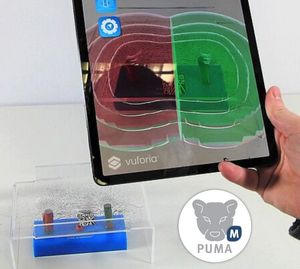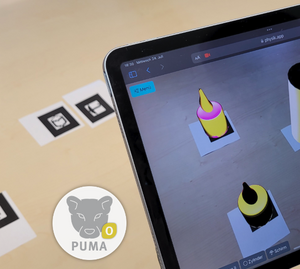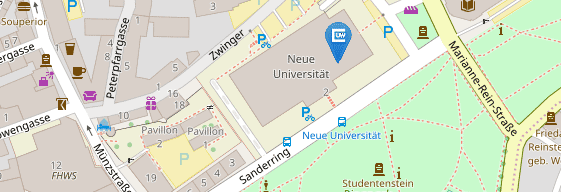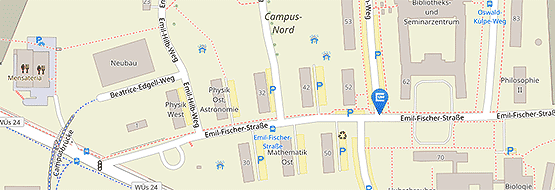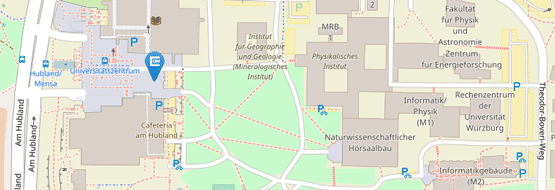Augmented Reality in physics classes
A promising application for the use of digital media in education is virtual and augmented reality. It creates opportunities (e.g. the visualisation of physical models in physics) to teach technical content in a completely new way. By linking real objects with additional digital information, the degree of abstraction for modelling is reduced, which can also counteract misconceptions.
In today's society, digital media are present in all areas of the vocational world. However, this image is not reflected in the every day school life or university teacher training programmes. In order to respond adequately to this development, it is therefore necessary to learn how to use digital media in the classroom or as part of a degree programme, or to have access to didactically valuable materials as a teacher (preferably free of charge).

PUMA (Physics lessons with augmentation)
To address this situation, we have launched the PUMA project at our department. PUMA stands for "Physics Lessons with Augmentation" and aims to design and test AR apps for various areas of physics. Following the evaluation phase, these apps will be available free of charge for use in physics lessons.
The following apps are currently available: Voltage Lab, Magnet Lab and Optics Lab.
PUMA: Voltage Lab
The "PUMA : Voltage Lab" application supports learners in developing correct conceptual knowledge of electricity. To do this, models of the electrical circuit are presented to match the experiments carried out by the learners.
This approach makes it easier and more intuitive to link observations made in the experiment (e.g. the brightness of a light) with their physical cause (e.g. the intensity of the flow of electrons through the light). The application offers the option of either projecting the model ideas over a real circuit using augmented reality (AR) or creating a virtual circuit in a simulation and enriching it with the model ideas.
PUMA: Magnet Lab
The"PUMA : Magnetlabor" application is a framework app for various experiment stations in a student laboratory. The scene to be worked on can be selected for each of the six different stations. The app is mainly used to display magnetic fields and atomic structures of the experiment. The internal logic of the various processes and their dependencies can be shown directly by means of automatically running animations. Some scenes allow interaction with the real experiment.
The augmentation of the magnetic fields for the real experiment is optimised for the Elektrik 2 box from MEKRUPHY. The components must be labelled with QR codes so that the app can recognise the components. You can download the targets here. To do this, print out the pdf file (set the printer to 100%), cut out the QR codes and stick them onto the described components and positions, preferably using a transparent adhesive film.
The app is part of a doctoral thesis at the Department of Physics and its Didactics and can be used as a supplement to real experiments. It is being used to investigate the influence of AR on various parameters of the cognitive learning process. There are plans to integrate real data from the experiment via Bluetooth to strengthen the link between experiment and virtuality.
PUMA: Optics Lab
Despite a great deal of effort to make the theory of optics clear in secondary level 1 physics lessons, (too) many pupils lack a clear understanding. Misconceptions such as "the mirror image lies on the mirror" or "the lens diameter determines the image size" persist. The "PUMA : Optics Lab" aims to counteract these misconceptions and provide teachers with a tool to train modelling concepts more comprehensibly and make them easier to visualise using a number of teaching modules and a specially developed, web-based augmented reality simulation. The development follows the "Design Based Research" (DBR) approach. In addition to the practical suitability of the app and the teaching material, the study focuses on the effect of WebAR on preconceptions and the change in misconceptions through short, targeted exercises with an AR simulation. The participating teachers use the materials in their ongoing lessons.
There are now many projects in which AR is used in teaching. Traditionally, a real experiment is carried out and enriched with additional virtual information via overlays. The PUMA : Optics Lab takes a different approach, which can be described as AR simulation. The entire experiment takes place in virtual space, while the haptic experience is retained. Conventional AR applications require the installation of a native app. The difficulties associated with this represent a hurdle that should not be underestimated, especially when used spontaneously in schools. This is why the PUMA : Optiklabor favours the use of web technologies. The application is opened in the browser like a website and is available with minimal effort. This increases the usability of the application immensely, as little storage space and no installation rights are required. The app records so-called "markers" that are placed on the table. The application uses these markers to position virtual devices such as multiple laser boxes, lenses or objects such as the earth, moon and sun. They are positioned by hand on the table and operated via the display of the mobile device.
Small teaching units have been designed for the markers, which can be integrated into your own lessons like small "snacks". The specific application scenario is not specified by the study, but is deliberately left to the teacher and documented. This opens up possibilities for the development or consolidation of subject content, homework and the preparation and follow-up of lessons and assessments.
Induction AR
InductionPiDAR is an AR application on the subject of induction. It is modelled on a real experiment with a bar magnet and an electromagnetic coil. An induction voltage can be generated in the electromagnetic coil via its relative movement. The position of the electromagnetic coil is defined in the app using a marker, while the position of the magnet is determined by the position of the mobile device. If, for example, the tablet used is moved in relation to the marker, the magnet moves in relation to the electromagnetic coil and induces a (virtual) induction voltage.
This voltage is detected in the app either via the display on a moving coil instrument or an oscilloscope. In addition, a light bulb lights up depending on the induction voltage generated.
The number of turns of the coil and the number of bar magnets used can be changed. In addition to the left-right or up-down movement of the magnet, it can also be rotated in space. It is also possible to display a three-dimensional visualisation of the magnetic field of the bar magnet.
To use the app, you can download the QR code here.
For further information, please contact Dr Christoph Stolzenberger.






